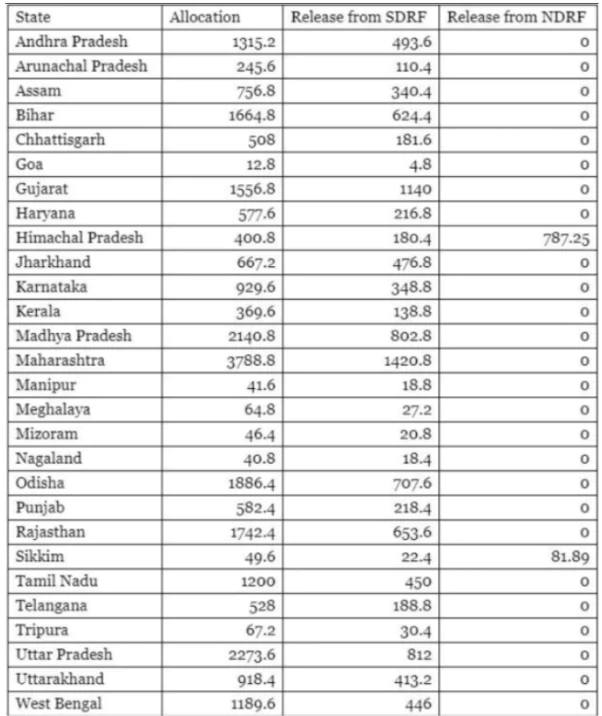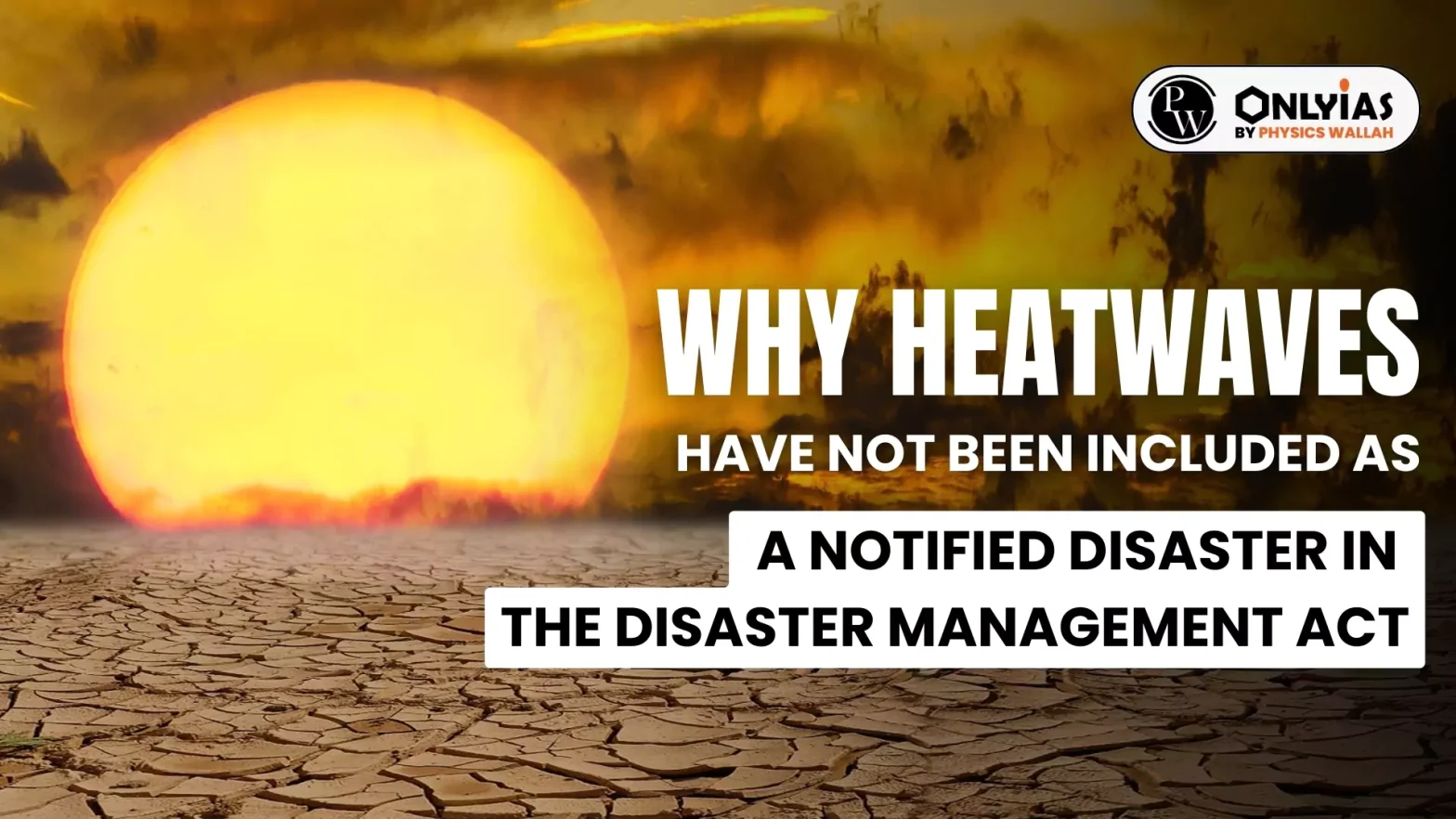The ongoing spell of extreme heat in many parts of the country has once again reopened discussions on the inclusion of heatwaves as one of the notified disasters under the Disaster Management (DM) Act, 2005.
What are Notified Disasters?
- Implications of Including Heatwaves as Notified Disasters: If the heatwaves are included as notified disasters, states will be allowed to use their disaster response funds to provide compensation and relief, and carry out a range of other activities for managing the fallout of a heatwave.
- Currently, states need to use their own funds for these activities.
- Disaster: The DM Act was enacted in the wake of the 1999 Odisha super-cyclone and the 2004 tsunami.
- It defines a disaster as a “catastrophe, mishap, calamity or grave occurrence” arising from “natural or man-made causes” that results in substantial loss of life, destruction of property, or damage to the environment.
- It must also be of such nature which is “beyond the coping capacity” of the community.
- Catastrophe:
- Definition: A very large-scale disaster causing widespread destruction and distress.
- Example: The 2004 Indian Ocean tsunami was a catastrophe because it caused immense loss of life, massive property damage, and affected many countries.
Enroll now for UPSC Online Course
- Mishap:
- Definition: A small, unfortunate accident or incident.
- Example: A kitchen fire caused by leaving the stove on is a mishap. It may cause some damage and inconvenience but is generally limited in scope and impact.
- Calamity:
- Definition: A serious event causing great and often sudden damage or distress; a disaster.
- Example: An earthquake that destroys homes and infrastructure, causing significant suffering to people, is a calamity.
- Major Categories of Disasters: Currently, there are 12 categories of disasters which are notified under this Act.
- These are cyclones, drought, earthquake, fire, flood, tsunami, hailstorm, landslide, avalanche, cloudburst, pest attack, and frost and cold waves.
- If such an event happens, then the provisions of the DM Act can be invoked.
Funding
- Types of Funds: The provisions allow states to draw money from the two funds that have been set up under this law – the National Disaster Response Fund (NDRF) at the national level and the State Disaster Response Fund (SDRF) at the state level.
- While the entire money of the NDRF comes from the central government, states contribute 25% of the money in the SDRF (10% in case of special category states), the rest comes from the Centre.
- Purpose: The money in these funds cannot be used for any purpose other than response and management of notified disasters.
- The states first utilise the funds available in the SDRF, and only if the magnitude of the disaster is unmanageable with the SDRF, states seek the money from the NDRF.
- In the FY 2023-24, only two states drew money from the NDRF (see box).

Check Out UPSC CSE Books From PW Store
Why Heatwaves Were Not Included As Notified Disasters?
- In the last 15 years, however, both the severity and frequency of heatwaves have increased.
- Due to increased economic activity, there is a far larger number of people who have to remain outdoors for their livelihoods or other reasons, exposing them to the risk of a heat- stroke.
- There are 23 states, which are vulnerable to heatwaves.
- Though heatwaves are not a new phenomenon in India, and heat-related illnesses and deaths have been common in large parts of northern, eastern and central India, these were not viewed as a disaster when the Act came into being in 2005.
- It was because heatwaves were a common occurrence during summer, and not really an unusual weather event.
- These states as well as several vulnerable cities have now prepared heat action plans (HAPs) to deal with the impacts of extreme heat.
- HAPs involve activities like creation of shaded spaces, ensuring availability of cool water in public places, distribution of simple oral solutions, and reorganising the schedules of schools, colleges and office working hours.
- These measures require expenditure but state governments have not been able to use the SDRF for them.
- This is the reason for the demand for inclusion of heatwaves as a notified disaster in the DM Act.
Why is the Centre not adding Heatwaves as a Notified Disaster now?
- Finance Commission Reluctance: States have put the demand of including heatwaves as a notified disaster before the last three Finance Commissions – the periodically established Constitutional body that decides on the distribution of financial resources between the Centre and states.
- However, the Finance Commissions have not entirely been convinced.
- The 15th Finance Commission, whose recommendations are currently being applied, said the existing list of notified disasters “covers the needs of the states to a large extent” and did not find merit in the request to include heatwaves.
- But it endorsed an enabling provision created by the preceding Commission that allowed states to utilise at least a part of the SDRF money – up to 10% – for “local disasters” such as lightning or heatwaves, which states could notify on their own.
- Using this new enabling provision, at least four states – Haryana, Uttar Pradesh, Odisha, and Kerala – have added heatwaves as local disasters.
- The Centre has so far resisted demands to notify it as a national disaster, using the Finance Commission as an excuse.
- Practical Difficulties:
- Although unstated, the main reason behind the reluctance to add heatwave as a notified disaster is the potentially huge financial implication of the move.
- The government has to provide monetary compensation – Rs 4 lakh – for every life lost because of a disaster that is in the notified list.
- Grievous injuries also have to be compensated.
- Heatwaves claim a large number of lives every year, even though the recorded number of deaths have not been very high in recent years. But this is changing.
- This year, more than 500 heat-related deaths have already been reported.
- Once the government is mandated to provide compensation, a larger number of deaths could be revealed.
- Other Reasons:
- The other reason is the problem in attributing deaths to heatwaves. In most cases, heat itself does not claim lives. Most people die due to other pre-existing conditions, made worse by the impact of extreme heat.
- It is often difficult to ascertain whether it was heat that made the difference.
- This is very different from other disasters in whose case the identification of the victims is easier and more straight-forward.
- For the five year period between 2021-26, the 15th Finance Commission had recommended an allocation of Rs 1,60,153 crore to the various SDRFs, a substantial sum of money.
- A state like Uttar Pradesh has been allocated about Rs 11,400 crore in its SDRF for the five-year period.
- Maharashtra’s share is the maximum, about Rs 19,000 crore.
- This money is meant to deal with all kinds of disasters during this period.
- The fear is that even this money could become insufficient if heatwaves and lightning – another disaster that claims a large number of lives every year – is added to the notified list of disasters.
Enroll now for UPSC Online Classes
Conclusion
Inclusion of heatwaves as notified disasters would facilitate better resource allocation and management, though financial and practical challenges hinder immediate implementation under the DM Act, 2005.
![]() 13 Jun 2024
13 Jun 2024


